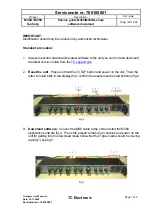
T2
– During time period T2, the input signal is not stable for a length of time equal to T1 (the debounce
time setting for this example.) Therefore, the output stays “high” and does not change state during
time period T2.
T3
– During time period T3, the input signal is stable for a time period equal to T1, meeting the debounce
requirement. The output is held at the high state. This is the same state as the input.
T4
– At anytime during time period T4, the input can change state. When this happens, the output will
also change state. At the end of time period T4, the input changes state, going low, and the output
follows this action [by going low].
T5
– During time period T5, the input signal again has disturbances that cause the input to not meet the
debounce time requirement. The output does not change state.
T6
– After time period T6, the input signal has been stable for the debounce time and therefore any edge
on the input after time period T6 will be immediately reflected in the output of the debounce module.
Mode Comparison
The following example shows how the two modes interpret the same input signal (which exhibits glitches).
Notice that the
Trigger Before Stable
mode will recognize more glitches than the
Trigger After Stable
mode. Use the
bypass
option to achieve maximum glitch recognition.
Example of Two Debounce Modes Interpreting the Same Signal
Debounce times should be set according to the amount of instability expected in the input signal. Setting a
debounce time that is too short may result in unwanted glitches clocking the counter. Setting a debounce
time too long may result in an input signal being rejected entirely. Some experimentation may be required
to find the appropriate debounce time for a particular application.
To see the effects of different debounce time settings, simply view the analog waveform along with the
counter output. This can be done by connecting the source to an analog input.
DaqBoard/3000 Series User’s Manual
918494
Counter Input Modes 5-3
Summary of Contents for OMB-DAQBOARD-3000 Series
Page 7: ...This product requires one of the following Operating Systems Windows 2000 Windows XP ...
Page 14: ...IG 8 DaqBoard Installation Guide 918494 1033 0940 rev 8 0 ...
Page 36: ...2 8 Connections Pinouts 918494 DaqBoard 3000 Series User s Manual ...
Page 40: ...4 2 Calibration 918494 DaqBoard 3000 Series User s Manual ...
Page 80: ...6 12 Setpoint Configuration for Output Control 908794 DaqBoard 3000 Series User s Manual ...
Page 102: ...DBK215 pg A 14 948894 Appendix A ...
Page 104: ...B 2 Hardware Analog Level Trigger 90794 Appendix B ...
















































